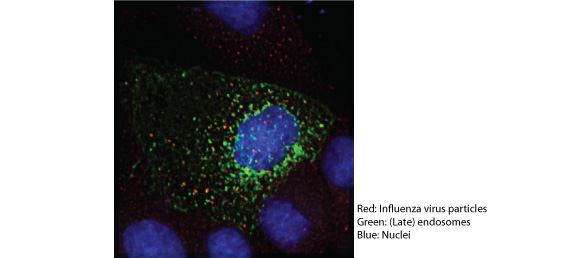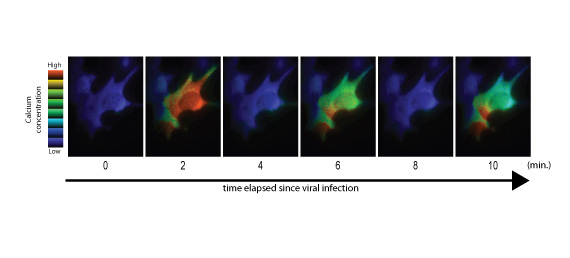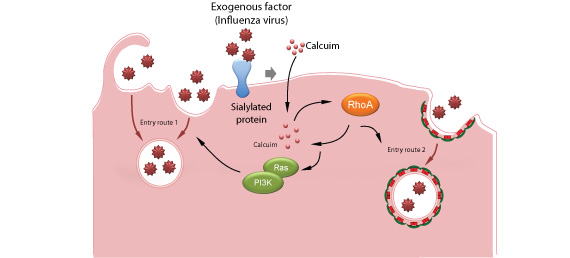Elucidation of the mechanism by which exogenous substances are internalized into cells: Prospects for the prevention of influenza virus infection
Research Press Release | December 10, 2013
-
 Fig. 1: The influenza virus is internalized by the cell, and has reached the intracellular organelles
Fig. 1: The influenza virus is internalized by the cell, and has reached the intracellular organelles -
 Fig. 2: Transient increase in intracellular calcium ion concentration due to viral infection
Fig. 2: Transient increase in intracellular calcium ion concentration due to viral infection -
 Fig. 3: The mechanism elucidated in this study whereby host cells internalize foreign factors
Fig. 3: The mechanism elucidated in this study whereby host cells internalize foreign factors
| Press Release | ||
|---|---|---|
| Key Points |
・ We discovered that an increase in intracellular calcium concentration is important in the internalization of exogenous factors. ・ We also discovered that influenza viruses utilize calcium elevation to enter host cells. ・ Calcium inhibition reduced the internalization of many substances, including influenza viruses. ・ Our results provide a new concept for the prevention of influenza virus infection and its potential for clinical application. |
|
| Overview |
Cells in our bodies respond to changes in the extracellular environment by activating the appropriate signaling pathways. Understanding these cellular responses is therefore extremely important for understanding cells’ physiological functions and in vivo homeostasis. In this study, we discovered the existence of a mechanism that actively attempts to internalize exogenous factors when cells are exposed to such factors. This mechanism consists of a signal transmission network comprising a variety of factors, chiefly an increase in the intracellular calcium ion concentration (1). We showed that influenza viruses, a class of such foreign factors, utilize this mechanism to efficiently enter host cells. As the process whereby the viruses enter cells is completely different from that targeted by conventional anti-influenza treatments, this offers the prospect of developing therapeutics based on a new concept. The results of this study were achieved in the research laboratory of the Department of Cell Physiology (Professor Yusuke Ohba) of Hokkaido University Graduate School of Medicine, in a study led mainly by Dr. Yoichiro Fujioka (Research Fellow of the Japan Society for the Promotion of Science), and have been published in Nature Communications. [Note 1] Calcium ions: Calcium is the most common mineral in the human body, and is involved in a variety of processes, including muscle contraction, nerve activity, enzyme activation, and hormone secretion, etc. The intracellular calcium ion concentration is maintained at a lower level compared with that outside cells, and a range of different signaling pathways are activated via an increase in the concentration of calcium ions in response to extracellular stimuli. |
|
| Inquiries |
Yusuke Ohba, Professor, Graduate School of Medicine, Hokkaido University TEL: +81-11-706-5158 FAX: +81-11-706-7877 E-mail: yohba@med.hokudai.ac.jp Department of Cell Physiology |
|
|
Japanese Link |
http://www.hokudai.ac.jp/news/131114_pr_med.pdf | |
| Publications | Nature Communications (2013.11.14 | |
